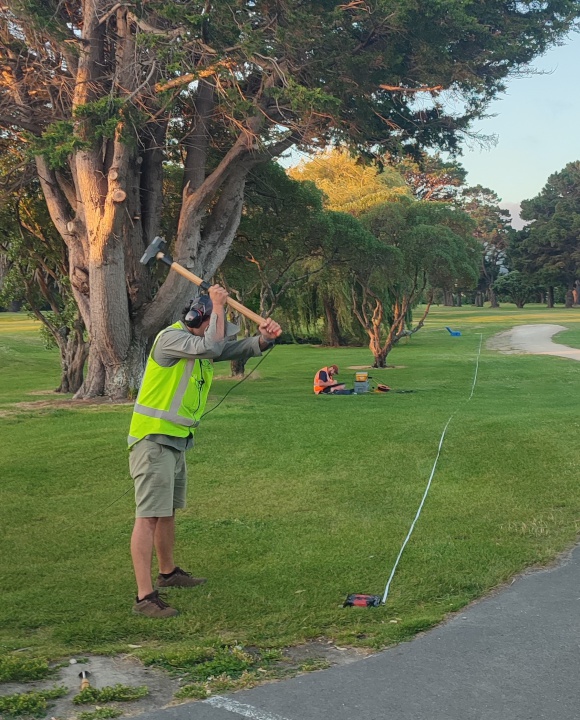Research Reveals Why Earthquake Shaking Varies Across Wellington
New research on the behaviour of the land underneath Wellington buildings during the 2016 Kaikōura earthquake has given engineers a much better understanding on how to make new buildings more seismically resilient in specific areas around the capital.

Researchers from the University of Canterbury use a sledgehammer to create vibrations which are recorded by the sensors to determine the composition of the soils below.
“Up until now, engineers typically have used a one-size-fits-all approach following the building code, but this new information allows them to decide which locations may need more resilient buildings and which buildings may need less strengthening interventions,” explains Professor of Earthquake Engineering Dr Brendon Bradley from the University of Canterbury.
Funding from Toka Tū Ake EQC enabled the team, led by the University of Canterbury along with other collaborating researchers, to analyse different sites around Wellington to help explain why so many buildings had suffered significant damage from the M7.8 Kaikōura earthquake on November 14, 2016.
“There has always been a lot of focus on the damage the faults under Wellington itself may cause, so it was alarming to see the significant damage to buildings in Wellington from relatively lower shaking produced by an earthquake more than 60 kilometres away,” says Professor Bradley.
From earlier earthquakes, scientists knew that seismic waves bounce around and are amplified in the Wellington soils. This is called the ‘basin effect’. The team from Canterbury wanted to quantify this more precisely and understand how it contributed to why some buildings suffered more damage than others.
The researchers investigated the locations with seismic instruments and compared the detailed GeoNet ground-motion data with the damage to buildings in that area.
“We found in certain places that the characteristics of the soils amplify the shaking over a narrow range of frequencies that can specifically affect 10-storey buildings, which were badly affected, but 20-storey buildings a lot less; while in other locations the findings could be the opposite,” says Bradley.
He explains that these findings will help engineers in designing new buildings, or assessing existing ones, to more accurately predict how the ground and the buildings could behave in future earthquakes and what measures they need to take to make those buildings seismically resilient in a cost-effective manner.
“Because there is a lot of variation in this basin amplification from location to location, it was difficult to recommend simple changes to the building standard, so instead we have created holistic guidance primarily for important safety-critical structures,” says Professor Bradley.
“These guidelines provide engineers with methods and tools for a more sophisticated design for buildings like hospitals and emergency facilities, but can also be used for ordinary buildings where clients want more confidence in the expected seismic performance.”
Toka Tū Ake invests around $10 million into natural hazard research each year and Dr Natalie Balfour, Head of Research at the natural hazard insurance agency, says that Professor Bradley’s project is a great example of research providing focussed outcomes for industry.
“Thanks to this type of research, Aotearoa New Zealand continually increases its knowledge around the impacts of natural hazards and helps engineers design more resilient buildings to reduce the disruption earthquakes have on the lives of people and their property,” says Dr Balfour.
Professor Bradley says that leading building designers for significant projects often already involve researchers to assist them in assessing seismic risks.
“And the more practitioners at the sharp end learn about these hazards, the more that knowledge will trickle down to others in the industry around them.”
Professor Bradley explains that the Toka Tū Ake Biennial Grant research in Wellington has created a platform for more research into this topic, which will be supported by the recently awarded Toka Tū Ake University Research Programme Grant.
“With the data we got from our site investigations in this grant, we will simulate future earthquakes in other areas of Wellington where we did not have earthquake data.
“On top of that, we also plan to expand the research to other main centres with significant seismic risk, like Auckland, Christchurch, Tauranga and Napier using the findings from this research to help predict how their soils may respond to future events,” says Professor Bradley.


 Netsafe: Statement From Netsafe About Proposed Social Media Ban
Netsafe: Statement From Netsafe About Proposed Social Media Ban The Reserve Bank of New Zealand: 2024 General Insurance Stress Test Results Published Today
The Reserve Bank of New Zealand: 2024 General Insurance Stress Test Results Published Today  Worldline: School Holidays And Long Weekends Change Regional Spending Patterns In April
Worldline: School Holidays And Long Weekends Change Regional Spending Patterns In April Stats NZ: Livestock Numbers Fall Over The Last 10 Years While Area Planted In Fruit Increases
Stats NZ: Livestock Numbers Fall Over The Last 10 Years While Area Planted In Fruit Increases Moths and Butterflies NZ Trust: Tagged Monarchs Found
Moths and Butterflies NZ Trust: Tagged Monarchs Found Master Plumbers Gasfitters and Drainlayers NZ: 2025 New Zealand Plumbing Conference Awards - Full List Of Winners
Master Plumbers Gasfitters and Drainlayers NZ: 2025 New Zealand Plumbing Conference Awards - Full List Of Winners